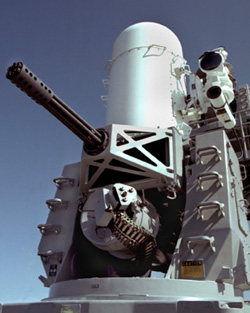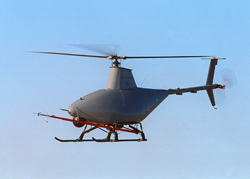Page 1
Daily News
By Gail Helmer
| Send Us News | Archives | Main |
Wednesday May 01, 2002
PC News
- New Screens: Strike Fighters: Project 1
- Steel Beasts Gold Editon Ships
- Raytheon and Canada Sign Phalanx 1B Order
- BAT Submunition Passes ATACMS Test
- Fire Scout VTUAV Prototype Ready for First Flight
New Screens: Strike Fighters: Project 1
Thirdwire Productions has sent us these new screens from Strike Fighters: Project 1, their 60's jet combat simulation. Strike Fighters is a fictional campaign is set in the 1960s and features the McDonnell Douglas F-4 Phantom II.
Steel Beasts Gold Editon Ships
Strategy First announced that a Special Gold Edition of Steel Beasts has shipped. Steel Beasts was first released in 2000 by Shrapnel Games. The game lets players take control of two powerful battle tanks--the US M1A1 Abrams and the German Leopard 2A4--in a series of missions. The new game includes a number of improvements such as better artificial intelligence, enhanced multiplayer performance, dozens of new missions, and other new features.
Military News
Raytheon and Canada Sign Phalanx 1B Order
Raytheon Company is being awarded a $29,850,000 contract to produce 21 Phalanx Block 1B upgrade kits for the Canadian Navy. This represents the single-largest contract to date for the surface mode of the Phalanx Close-In Weapon System.
All 21 kits will be produced at Raytheon Missile System's Louisville, Ky., facility and installed at the Raytheon Canada Naval Defence Systems Centre in Calgary, Alberta, Canada. The first kit will be delivered in September 2002 with the remaining kits following over a three-year period.
"This is a major undertaking for both Raytheon and the Canadian Navy," said Dennis Carroll, director of Phalanx systems in Tucson, Ariz. "Not only does this initiative promote Phalanx in the international community, it also makes the Canadian fleet one of the most modern in the world."
Phalanx is a rapid-fire, computer-controlled radar and 20-mm gun system that automatically acquires, tracks and destroys enemy threats that have penetrated all other ship defense systems. More than 850 systems have been built and deployed in the navies of 21 nations. Most recently, Phalanx Block 1B was installed aboard the USS Howard (DDG-83) and the USS Bulkeley (DDG-84), the U.S. Navy's newest Arleigh Burke-class Aegis destroyers.
"The Block 1B surface mode, our most advanced system, provides unequalled capabilities in near-shore, littoral environments," said Carroll. "It provides protection to ships and their crews against an increased number of threats including small, fast gunboats; standard and guided artillery; helicopters; mines and a variety of shore-launched, anti-ship missiles."
BAT Submunition Passes ATACMS Test
A US Army and Northrop Grumman Corporation team have conducted a successful flight test of the Brilliant Anti-Armour Submunition (BAT) dispensed by an Army Tactical Missile System (ATACMS) carrier missile.
The objective of the test was to demonstrate the performance of the BAT submunition against a moving array of armoured vehicles equipped with countermeasures. Some of the BATs were fitted with warheads, while others carried flight data recorders to substantiate pre-test modelling and simulations.
"A preliminary evaluation indicates that the flight test was highly successful, with all submunitions appearing to operate reliably," said Emmitt Gibson, vice president of Precision Munitions at Northrop Grumman's Electronic Systems sector. Official results are not yet available, but according to early feedback, the BAT's performance exceeded the Army's operational requirements.
Following deployment from the ATACMS missile, the BATs deployed their aerodynamic surfaces, acoustically acquired the moving targets and manoeuvred to the target area. The submunitions recorded hits on all three types of target vehicles (tanks, armoured personnel carriers, and self-propelled howitzers) despite the presence of countermeasures.
The BAT, which is currently in low-rate initial, is an autonomous submunition that uses a combination of passive acoustic and infrared sensors to seek, identify and destroy moving armoured targets deep in enemy territory. Northrop Grumman is under contract to supply the Army with approximately 1,200 BATs.
Fire Scout VTUAV Prototype Ready for First Flight
The U.S. Navy's RQ-8A Fire Scout vertical takeoff and landing tactical unmanned air vehicle (UAV) system has moved closer to demonstrating its role as a force multiplier for the Navy and Marine Corps forces ashore.
Northrop Grumman Corporation's Fire Scout prototype, a technology demonstrator for the RQ-8A program, recently moved from the company's engineering facility here to the Naval Air Warfare Center test range at China Lake, Calif., for final first flight preparations. First flight of the prototype is planned for later this spring.
The Fire Scout system, a vertical takeoff and landing tactical UAV, is in low-rate initial production for the U.S. Navy by the Integrated Systems sector. Fire Scout will fly at an altitude of up to 20,000 feet, and use an advanced payload with an electro-optical/infrared sensor and a laser designator to survey littoral regions with pinpoint accuracy, giving military decision-makers the most current information about enemy resources and personnel on the ground.
Fire Scout is a fully autonomous targeting and surveillance system that can fly almost silently above deployed Marines to watch for hidden enemies within 100 nautical miles. The system then directs Navy and Marine weapons with the laser designator accurately to the target. The first Fire Scout system was designed to respond to the Marine Corps requirements and will include three unmanned air vehicles, two ground control stations, a data link suite and modular mission payloads.
| Send Us News | Archives | Main |


